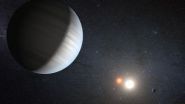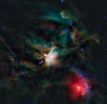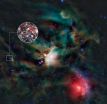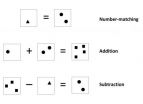(Press-News.org) The system, known as Kepler-47, harbours the smallest known transiting circumbinary planets -- planets orbiting a pair of stars -- to date. The planets were discovered using NASA's Kepler space telescope [1] by monitoring thefaint drop in brightness produced when both planets transit (eclipse) their host stars [2].
"In contrast to a single planet orbiting a single star, planets whirling around a binary system transit a moving target," explains Jerome Orosz (San Diego State University, USA), lead author of the study. "The time intervals between the transits and their duration can vary substantially, from days to hours, and therefore the extremely precise and almost continuous observations with Kepler space telescope were fundamental."
This planetary system is located roughly 5000 light-years away from Earth, in the constellation of Cygnus (The Swan). The pair of stars whirls around each other every 7.5 days. One star is similar to our Sun while the other is a diminutive star only one third the size and 175 times fainter.
Thanks to Kepler's observations, astronomers were able to characterise the planetary system. The inner planet -- Kepler-47b -- is only three times larger in diameter than the Earth and orbits the stellar pair every 49 days. The outer planet -- Kepler-47c -- is about 4.5 times the size of the Earth -- slightly larger than Uranus -- and orbits the stars every 303 days. This makes the outer planet the longest-period transiting planet currently known.
More importantly, the outer planet's orbit places the planet well within what astronomers refer to as the habitable zone -- the region around a star within a terrestrial planet that could have liquid water on its surface.
"While the outer planet is probably a gas giant planet and thus not suitable for life, large moons, if present, would be interesting worlds to investigate as they could potentially harbour life," says William Welsh (San DiegoState University, USA), co-author of the study.
Since both planets are rather small, they do not gravitationally disturb the stars or each other measurably. Hence their masses cannot be directly measured. However, astronomers can place upper limits to their masses, showingthat these small objects are certainly planets and not brown dwarfs [3]. Based on their size, the inner and outer planets probably have masses of approximately 8 and 20 times that of the Earth, respectively.
"Since about one third of all stars are either binary or multiple star systems, finding planets in binary star systems has very important implicationsnot only for estimating the total numbers of planets that exist, but for how star-planet systems form as well," concludes Jerome Orosz.
INFORMATION:
Notes
[1] Kepler is a space observatory operated by NASA aimed to survey a portion of our region of the Milky Way galaxy to discover Earth-like planets in or near the habitable zone and determine how many of the billions of stars in our galaxy have such planets.
[2] The loss of light caused by the eclipse is tiny, only 0.08% for Kepler-47b and 0.2% for Kepler-47c. By comparison, Venus blocked about 0.1% of the Sun's surface during its recent transit on 5 June 2012.
[3] Brown dwarfs are objects between stars and planets in size. They are not massive enough to fuse hydrogen in their cores but are larger than giant planets such as Jupiter.
More information
The IAU is an international astronomical organisation of about 10 000 professional astronomers from 90 countries. Its mission is to promote and safeguard the science of astronomy in all its aspects through international cooperation. The IAU also serves as the internationally recognised authority forassigning designations to celestial bodies and surface features on them.
Contacts
Jerome A. Orsz
San Diego State University
San Diego, USA
Tel: +1 619 594 7118
Email: orosz@sciences.sdsu.edu
William F. Welsh
San Diego State University
San Diego, USA
Email: wfw@ogedei.sdsu.edu
Lars Lindberg Christensen
IAU Press Officer / ESO ePOD
Garching bei München, Germany
Tel: +49 89 3200 6761
Cell: +49 173 3872 621
Email: lars@eso.org
Kepler discovers planetary system orbiting two suns
2012-08-29
ELSE PRESS RELEASES FROM THIS DATE:
Sweet building blocks of life found around young star
2012-08-29
Life is made up of a series of complex organic molecules, including sugars. A team of astronomers led by researchers from the Niels Bohr Institute, have now observed a simple sugar molecule in the gas surrounding a young star and this discovery proves that the building blocks of life were already present during planet formation. The results have been published in the scientific journal Astrophysical Journal Letters.
The star was observed with the new large international telescope, Atacama Large Millimeter Array (ALMA) in northern Chile. The ALMA telescopes are able to ...
Sweet result from ALMA
2012-08-29
A team of astronomers using the Atacama Large Millimeter/submillimeter Array (ALMA) has spotted sugar molecules in the gas surrounding a young Sun-like star. This is the first time sugar been found in space around such a star, and the discovery shows that the building blocks of life are in the right place, at the right time, to be included in planets forming around the star.
The astronomers found molecules of glycolaldehyde -- a simple form of sugar [1] -- in the gas surrounding a young binary star, with similar mass to the Sun, called IRAS 16293-2422. Glycolaldehyde ...
Adelaide joins with Italy to develop 'super spaghetti'
2012-08-29
University of Adelaide researchers are working with colleagues in Italy to produce better quality pasta that also adds greater value to human health.
Two research projects - being conducted by the ARC Centre of Excellence in Plant Cell Walls at the University's Waite Campus - will start next month in collaboration with researchers from the Italian universities of Bari and Molise.
The aim of the ARC Centre of Excellence is to look at the fundamental role of cell walls (biomass) in plants and discover how they can be better utilized. Both of these new projects will investigate ...
Math ability requires crosstalk in the brain
2012-08-29
A new study by researchers at UT Dallas' Center for Vital Longevity, Duke University, and the University of Michigan has found that the strength of communication between the left and right hemispheres of the brain predicts performance on basic arithmetic problems. The findings shed light on the neural basis of human math abilities and suggest a possible route to aiding those who suffer from dyscalculia-- an inability to understand and manipulate numbers.
It has been known for some time that the parietal cortex, the top/middle region of the brain, plays a central role ...
New 'traffic light' test could save lives with earlier diagnosis of liver disease
2012-08-29
A new 'traffic light' test devised by Dr Nick Sheron and colleagues at University of Southampton and Southampton General Hospital could be used in primary care to diagnose liver fibrosis and cirrhosis in high risk populations more easily than at present.
Liver disease develops silently without symptoms, and many people have no idea they have liver failure until it is too late – one-third of people admitted to hospital with end-stage liver disease die within the first few months. A simple test available in primary care could diagnose disease much earlier, enabling those ...
Internet addiction -- Causes at the molecular level
2012-08-29
"It was shown that Internet addiction is not a figment of our imagination," says the lead author, Privatdozent Dr. Christian Montag from the Department for Differential and Biological Psychology at the University of Bonn. "Researchers and therapists are increasingly closing in on it." Over the past years, the Bonn researchers have interviewed a total of 843 people about their Internet habits. An analysis of the questionnaires shows that 132 men and women in this group exhibit problematic behavior in how they handle the online medium; all their thoughts revolve around the ...
Twitter data crunching: The new crystal ball
2012-08-29
Fabio Ciulla from Northeastern University, Boston, USA, and his colleagues demonstrated that the elimination of contestants in TV talent shows based on public voting, such as American Idol, can be anticipated. They unveiled the predictive power of microblogging Twitter signals--used as a proxy for the general preference of an audience--in a study recently published in EPJ Data Science¹.
The authors considered the voting system of these shows as a basic test to assess the predictive power of Twitter signals. They relied on the overlap between Twitter users and show audience ...
Earphones 'potentially as dangerous as noise from jet engines,' according to new study
2012-08-29
Turning the volume up too high on your headphones can damage the coating of nerve cells, leading to temporary deafness; scientists from the University of Leicester have shown for the first time.
Earphones or headphones on personal music players can reach noise levels similar to those of jet engines, the researchers said.
Noises louder than 110 decibels are known to cause hearing problems such as temporary deafness and tinnitus (ringing in the ears), but the University of Leicester study is the first time the underlying cell damage has been observed.
The study has ...
New research eclipses existing theories on moon formation
2012-08-29
Oxford, August 29, 2012 - The Moon is believed to have formed from a collision, 4.5 billion years ago, between Earth and an impactor the size of Mars, known as "Theia." Over the past decades scientists have simulated this process and reproduced many of the properties of the Earth-Moon system; however, these simulations have also given rise to a problem known as the Lunar Paradox: the Moon appears to be made up of material that would not be expected if the current collision theory is correct. A recent study published in Icarus proposes a new perspective on the theory in ...
Don't cut lifesaving ICDs during financial crisis, ESC warns
2012-08-29
Implantable devices for treating cardiac arrhythmias, which include ICDs, are already underused in parts of Eastern and Central Europe and there is a risk that the financial crisis could exacerbate the problem. The European Heart Rhythm Association (EHRA), a registered branch of the ESC, is tackling this issue through ICD for Life. The initiative aims to raise awareness about the importance of ICDs and sudden cardiac death in countries in Central and Eastern Europe.
ICD implantation rates in Europe vary widely, ranging from 1 ICD implantation per million inhabitants in ...




